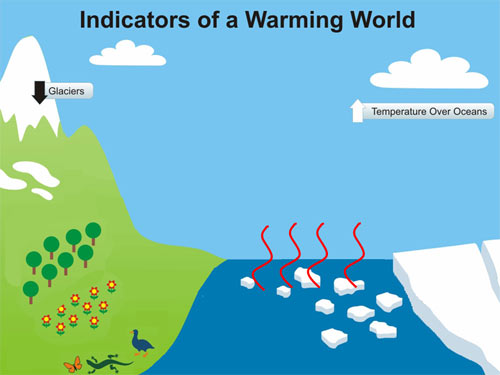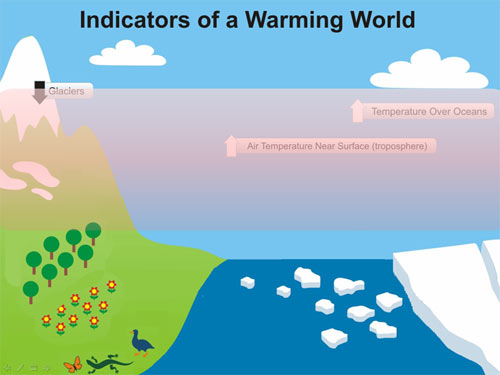Another animated version of the Warming Indicators Powerpoint
Posted on 18 May 2011 by John Cook
Back in February, Chip Fletcher from the University of Hawaii created an animated powerpoint of the Indicators of Warming, useful for public talks where the various warming indicators appeared one at a time. Shortly afterwards, Martin Hedberg created an updated version of this powerpoint, adding some fancy fade-in effects. Now Shawn Brooks, standing on the shoulders of giants, has taken the Warming Indicators powerpoint one step further - adding more animated effects to illustrate the various signs of warming being observed.
You can download Shawn's powerpoint here. Shawn is a Canadian teacher, creating this for his Year 10 class. Some of his additions include animated heat lines denoting ocean warming:

A flash of warmth to show tropospheric warming:

And diminishing sea ice and ice sheets:

As creative people continue to incrementally add to this resource, I find myself looking forward to the next iteration of the animated powerpoint and wondering where this will all end. Warming Indicators: The Motion Picture?































 Arguments
Arguments






























[DB] Glacial mass-balance is a function of deposition in the glacier's accumulation zone (where it "packs on weight"), and its losses in the ablation zone (everywhere else). Additionally, slope and terrain play a role as well.
If the glacier is getting substantially more deposition through enhanced snowfall in its accumulation zone, it may begin to advance further downslope (that gravity naughtiness). However, increased meltwater pulses due to a warmer environment downslope may actually cause even greater acceleration and calving at the output end of the glacier due to basal lubrication and subsequent retreat upslope of the glacier.
Measurements of glacier thickness, accumulation and ablation worldwide are reflected in the enclosed graphic. In addition to the graphic I provide, see Jimbo's comment at #2 and glaciologist Mauri Pelto's site here:
[Source]
The reality is that hard-working glaciologists have been all over this for many decades. And this is all very well-documented in the literature. And at Skeptical Science (that Search function thingy).
[DB] Then go to Mauri's page I linked to. Or better yet, the primary literature in addition to the WGMS site Jimbo gave you.
[DB] You are far, far off-topic here. Many posts exist at SkS (Search thingy will find them). SLR about 7 meters from Greenland & Canadian Archipelago, 7 meters or so from WAIS, another 60-65 meters from the EAIS. Even a partially melted ice cap is a very bad thing for people.
No human civilization we are aware of was around the last time sea levels were at that level.
Please focus on the topic of this thread from this point on.
[DB] Google is your friend. You can look this stuff up yourself, you know, rather than asking.
[DB] This is off-topic for this thread.
[DB] KR earlier gave you the link to the USGS site, which itself detailed the sources for the 80 meters quoted. You are welcome to reinvent the wheel all you like, but not on this thread. This is now off-topic and further comments on this will be deleted.